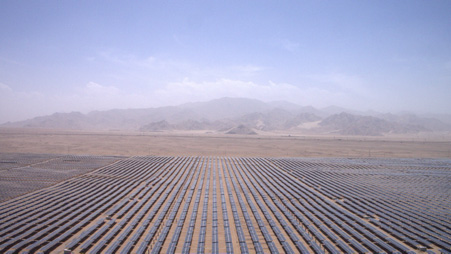
Trina Solar, the global leader in photovoltaic (PV) and smart energy solutions, anticipates that the increased prevalence of bifacial solar modules in Australian installations will drive demand for smart tracker technology.
Trina Solar senior country sales manager, Govind Kant, says: “Customers are increasingly turning to bifacial modules because of the extra power that these modules can deliver at a relatively small cost premium. Bifacial generates power from the front and backside of the module.”
“But generating power from the backside of the module, which is facing the ground, poses its own set of challenges because you need to angle the panel to optimize the amount of light that the front and back can receive.”
“To do that, you need smart tracker technology. This is why the adoption of bifacial modules will drive demand for smart trackers,” says Kant.
Trina Solar’s Asia-Pacific director of solution services, Holger Schenk, says: “Typical tracker algorithms use astronomical algorithms. Based on the geolocation, using GPS, and the time of day, it calculates the location of the sun.”
“But if it is cloudy, you don’t have direct sunlight. You have diffused sunlight. The clouds are breaking the sunlight and now you don’t have light from one source. It may not be beneficial to angle the module directly towards the sun,” says Schenk.
“Instead it may be better to deviate, so as to harvest diffused sunlight. The smart tracker measures direct sunlight and diffused sunlight to determine the optimal angle,” he says. Diffused sunlight is measured using a special sensor.
He says: “Another factor is terrain. You have rows of modules and each row could potentially create a shadow on each other. If one row is on the slope of a hill and another is on lower ground, there could be shading. If you have the topographical data, you can change the angle to avoid shading.”
The smart tracker algorithm makes use of the topographical data and it has, what is called, backtracking where you move the module out of the ideal position so as to reduce the shadows.
For bifacial modules, measuring diffused sunlight reflected off the ground is also an important factor to consider.
“In some instances, more sunlight may be harvested if you deviate from the angle to maximize diffused sunlight reflected from the ground.”
Schenk says bifacial modules with conventional sun tracking trackers and some ground treatment, such as white gravel to increase reflection, will generate 30% more power output than a fixed tilt mono-facial module.
But if the smart tracker is used, with the more advanced algorithms, then you can get an extra 4% energy gain as compared to a conventional algorithm, he says.
Trina Solar used the smart tracker technology for a solar farm in Golmud, in northwest China. It has yet to introduce the technology to Australia, but is now working to introduce it into this market.
“Because we manufacture modules and trackers, we have a better understanding of how the tracker technology works with the modules,” says Schenk.

(Photo: 5MW Golmud PV Power Plant in Qinghai, China)
